Von einer Jury wurden Pia Schmikl, Kervin Saint Pere und Saray Purto Hoffmann als Preisträgerinnen für den RUNDGANG 50HERTZ im Jahr 2023 ausgewählt.
Die öffentliche Ausschreibung erfolgte für den RUNDGANG 50HERTZ zum Thema «Displacement als ästhetische Strategie». Aufgerufen zur Bewerbung waren Hochschulabsolvent*innen, die im Sinne eines transdisziplinären Ansatzes das Thema displacement in ihrer künstlerischen Arbeit aufgreifen. Mit displacement ist die Verschiebung eines Gegenstandes von einem Ort oder Zusammenhang in einen anderen gemeint. Was passiert mit einem Objekt, wenn es irgendwo ankommt, wohin es traditionellerweise nicht gehört? Warum befindet es sich dort? Welche Bedeutung hat es am Ursprungsort und welche Bedeutung erlangt es durch displacement an der neuen Stelle? Was passiert mit seinem neuen Umfeld? Und was ereignet sich in dem neuen Zusammenhang bei dem*der Betrachter*in, der*die es entdeckt? Das Thema ist im Kontext der Restitution von Kulturgütern intensiv besprochen worden. Es lässt sich aber vielfältig verstehen und auch als künstlerische Methodologie begreifen: displacement des Kunstobjekts, displacement des*der Betrachter*in, displacement des Ausstellungskontextes oder ganz grundlegend als globales Faktum der Gegenwart (etwa Migrationsbewegungen). Displacement ist zugleich ein Phänomen der Natur und kann ebenso einen mentalen Zustand meinen. Ein Aspekt dieser Thematik soll in der ein-gereichten künstlerischen Arbeit sichtbar sein.
Pia Schmikl, Kervin Saint Pere and Saray Purto Hoffmann were selected by a jury as the prizewinners for the RUNDGANG 50HERTZ in 2023.
The public call for RUNDGANG 50HERTZ was on the topic of “displacement as an aesthetic strategy”. Arts academy graduates who take up the subject of displacement in their artistic work in the sense of a transdisciplinary approach were invited to apply. Displacement means the shifting of an object from one place or context to another. What happens with an object if it arrives somewhere where it traditionally does not belong? Why is it there? What significance does it have at its original site and what significance does it acquire at the new location through displacement? What happens with its new environment? And what happens in the new context in the viewer who discovers it? The topic has been intensively discussed in the context of the restitution of cultural artefacts. It can, however, be understood in manifold ways, and can also be grasped as an artistic methodology: displacement of the art object, displacement of the viewer, displacement of the exhibition context, or quite fundamentally as a global fact of the present day (as in, for instance, migratory movements). Displacement is at the same time a natural phenomenon and can also be thought of as a mental state. One aspect of these issues was intended to be visible in the artistic work submitted.
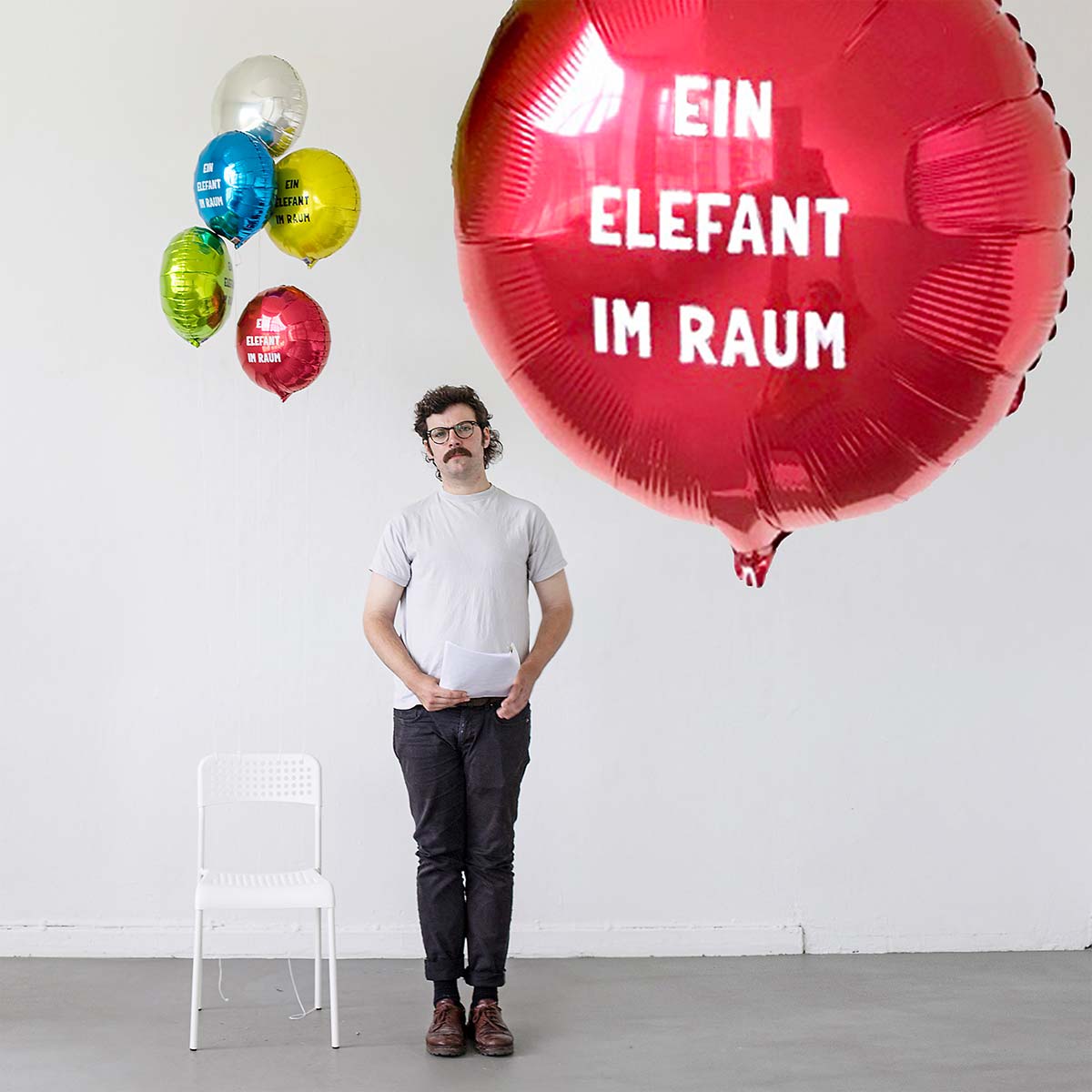
Den Ausgangspunkt der Arbeit von Pia Schmikl bildet ein Gedankenspiel. Nähme man die Metapher «der Elefant im Raum» wörtlich, könnte man sich dann des Problems, für das der Elefant als Bild herhalten muss, entledigen? Die Künstlerin recherchiert die etymologische Herkunft der Redewendung, geht verschiedenen Quellen nach, entdeckt den Elefanten in anderen Disziplinen, in Lyrik, Psychologie und Geschichte. Dabei interessieren sie zwischenmenschliche Beziehungen, elementare Bedürfnisse und komplexe Beziehungsnetze. Sie spürt der Figur des Elefanten nach und erzählt, was sie antrifft. Warum wurde gerade dieses Tier als Metapher für ein schwerwiegendes und von allen Beteiligten unaussprechliches Problem gewählt? Die Recherche wird in einer poetologisch-humorvollen one-person lecture-performance aufgeführt. Es ist eine multiperspektivische Nacherzählung, in der verschiedene Blickwinkel auf den Elefanten aufgezeigt werden, und damit ist es auch eine Neuerzählung, versehen mit subtilen Handlungsvorschlägen.
The starting point for Pia Schmikl’s work is a mental game. If we were to take the metaphor “the elephant in the room” literally, could we then rid ourselves of the problem for which the elephant is used as an image? The artist researches the etymology of the figure of speech, investigates various sources, discovers the elephant in other disciplines, in poetry, psychology and history. What interests her in the process are interpersonal relationships, basic needs and complex networks of relations. She traces the figure of the elephant and recounts what she comes across. Why was precisely this animal selected as a metaphor for a weighty problem that cannot be spoken about by everyone involved? Her research is performed in a poetological and humorous one-person lecture-performance. It is a multi-perspectival retelling, in which different angles towards the elephant are shown; in that way it is also a re-narration, providing subtle proposals for actions.
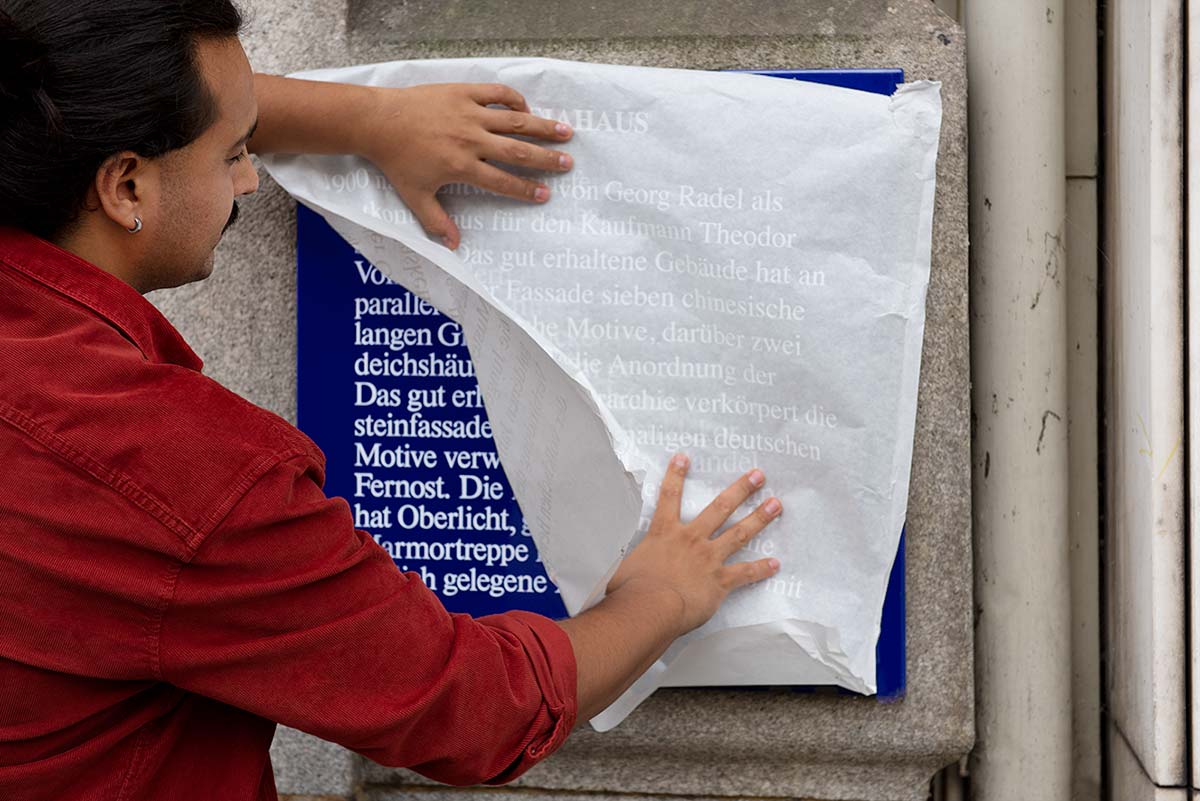
In Hamburg wird die Geschichte von Kulturdenkmälern auf blauen Tafeln erzählt, die gut sichtbar an der Fassade der Monumente angebracht sind. Dieser Geschichte geht Kervin Saint Pere auf den Grund – und fördert zutage, was verschwiegen wird. Er forscht in Archiven und Bibliotheken, liest sich in die Vergangenheit der Stadt und ihrer Denkmäler ein. So findet er heraus, dass zum Beispiel bei der Würdigung des sogenannten Afrikahauses die Gründerfirma Woermann zwar auf der blauen Tafel genannt wird, aber unerwähnt bleibt, dass diese über Militärtransporte am Genozid an den Herero und Nama beteiligt war. Der Künstler ergänzt das vorgefundene Narrativ um die von ihm recherchierten Fakten, die er, auf Seidenpapier gedruckt, über die bisherige Darstellung legt. Diese als «Para-Monumente» bezeichneten Interventionen mit dem Titel «Die Stadt Hamburg und ihr Nachleben des Kolonialismus» erweitern das offizielle Geschichtsbild um verschwiegene oder verdrängte Dimensionen.
In Hamburg, the history of cultural landmarks is told on blue plaques that are mounted on the monuments’ facades in a clearly visible manner. Kervin Saint Pere gets to the bottom of this history—and reveals what has been concealed. He researches in archives and libraries, reads up on the city’s past and on its historical monuments. He finds out, for instance, that the original company Woermann is indeed referred to on the blue plaque acknowledging the so-called Africa House, but that it remains unmentioned that they were involved in the genocide of the Herero and Nama peoples by providing military transports. The artist supplements the narrative one comes upon to include the facts he has researched; he applies them, printed on tissue paper, on top of the previous representation. These interventions, designated “para-monuments” and entitled “The City of Hamburg and its Afterlife of Colonialism”, broaden the official picture of history so that it encompasses concealed or repressed dimensions.
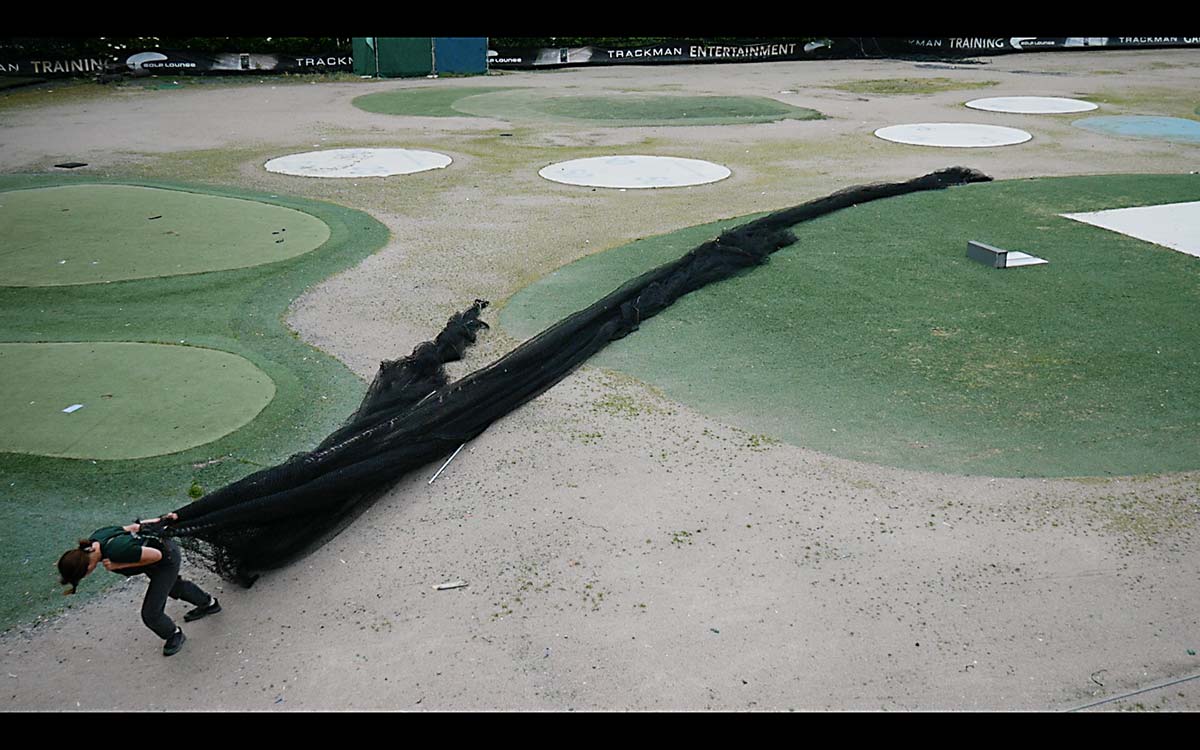
«Il Trasloco» (Der Umzug) – so heißt die Arbeit von Saray Purto Hoffmann. Sie besteht aus mehreren großformatigen Haufen, zu Bündeln geschnürt und mit grauer Farbe bemalt. Unter einem straff gespannten Tuch lassen sich die Konturen von Dingen wie einem Stuhl, einer Leiter, einem Tisch sowie vielen Kisten und Kästen deutlich erkennen. Daneben zeigt ein Video, wie die im Ausstellungsraum aufgetürmten Gegenstände an einem Seil durch eine Landschaft gezogen werden. Schwerfällig wirken die Bündel im Raum und mühsam erscheint ihr Transport, die Künstlerin nennt es «carrying the house on one’s back». Vermittels dieser Arbeit fragt sie nach den Bedingungen von Migration und Mobilität. Sie fragt danach, wie wir uns durch Benutzung in ein Objekt einschreiben und gleichzeitig durch das Objekt geprägt werden, indem es die Art und Weise, wie und wo wir leben und wie wir unsere Gesellschaft organisieren, beeinflusst.
“Il Trasloco” (The Relocation) is the name of Saray Purto Hoffmann’s work. It consists of a number of large-format piles, tied in bundles and painted gray. Under a tightly stretched cloth, the contours of things like a chair, a ladder, a table and many boxes and crates can clearly be identified. Next to them, a video shows the objects piled up in the exhibition room being pulled on a rope through a landscape. The bundles look cumbersome in the space, and it appears to be onerous to transport them; the artist calls it “carrying the house on one’s back”. Through the medium of this work, she inquires into the conditions of migration and mobility. She poses the question of how we inscribe ourselves into an object by using it, and at the same time are shaped by the object as it influences the manner in which and where we live, and how we organise our society.
Preisträgerinnen des RUNDGANG 50HERTZ im Jahr 2022 sind:
Clara Alisch, Lisa Hoffmann, Steph Joyce – Sie wurden von einer Jury ausgewählt.
Der RUNDGANG 50HERTZ 2021/22 stand unter dem Motto «Crossover von Kunst und Wissen»: Zu welchen neuen Formen des Erkennens im Bereich des Ästhetischen führt eine Verzahnung der Künste mit Wissenschaften oder handwerklichen Praktiken? In welchem Verhältnis stehen analytische Reflexion und praktisches Handeln? Fragestellungen dieser Art bestimmen die Diskussion, die seit den 1990er-Jahren unter den Begriffen «künstlerische Forschung» oder «Kunst und Epistemologie» an verschiedenen Kunsthochschulen in Europa unterschiedlich intensiv geführt wird. In der Debatte schwingt stets die Frage nach der An- oder Aberkennung des epistemologischen Gehalts der Künste sowie die Möglichkeit, diesen nachzuweisen, mit. Wir möchten die Notwendigkeit dieser Diskussion aus der gegenwärtigen Situation der Künste heraus mit dem Call thematisieren.
The prizewinners of the RUNDGANG 50HERTZ in 2022 are:
Clara Alisch, Lisa Hoffmann, Steph Joyce – They were selected by a jury.
The theme of RUNDGANG 50HERTZ 2021/22 was „Crossover of art and knowledge“: To what new forms of cognition in aesthetics does linking the arts with sciences or artisanal practices lead? What is the relationship between analytical reflection and practical action? Questions of this type have been dominating the discussion conducted at various arts academies in Europe since the 1990s with varying intensity under the terms “artistic research” or “art and epistemology”. In the debate, the question always resonates about the recognition or denial of the epistemological content of the arts, as well as the possibility to prove it. With the call, we would like to broach the necessity in this discussion arising from the current situation of the arts.
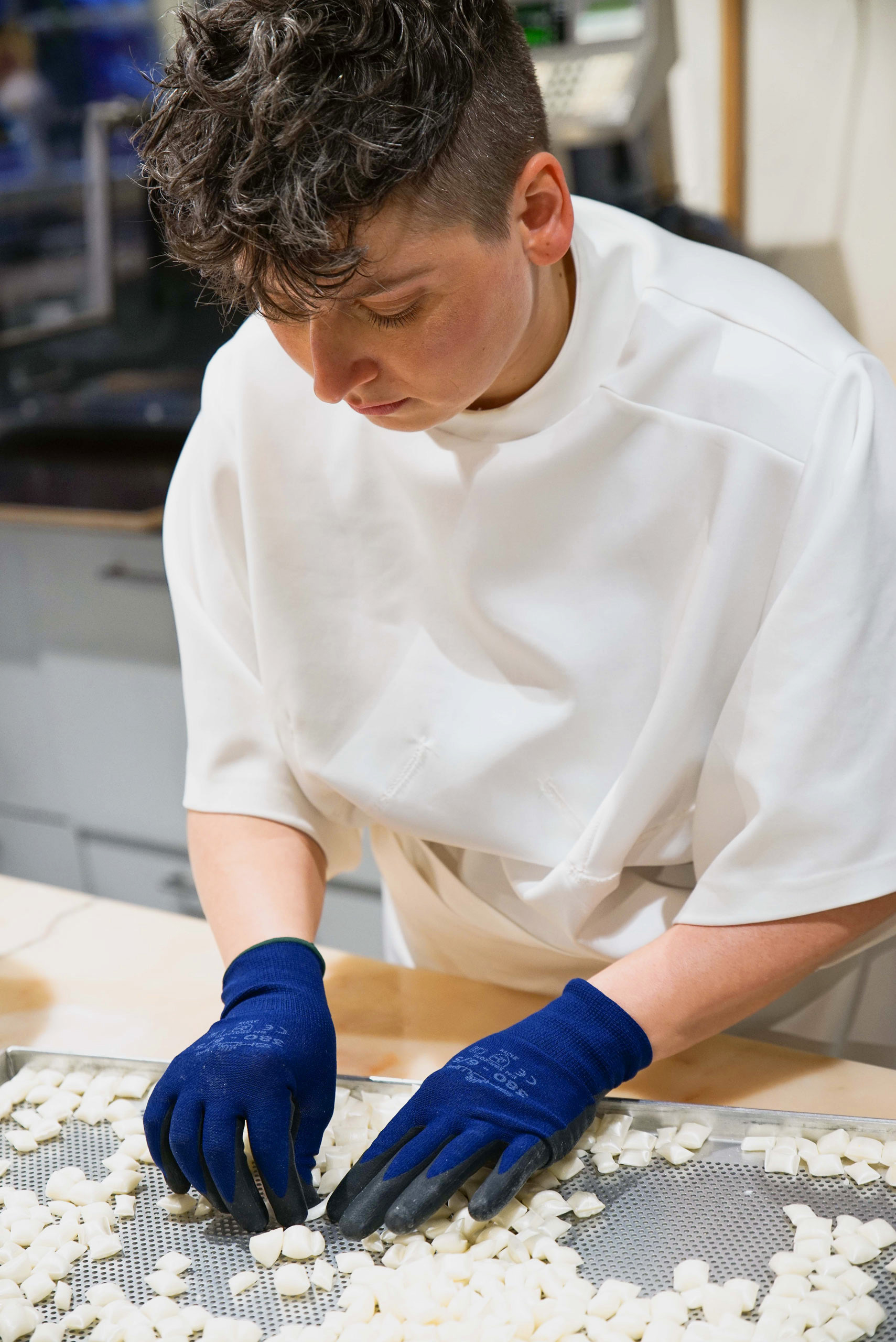
Clara Alisch (* 1986 in Münster) thematisiert in ihrer Videoinstallation Lactoland (2021) die verklärte Vorstellung, die mit dem Stillen an der Brust und dem damit verknüpften Mutterbild verbunden ist. Es geht um reproduktive Arbeit (care work), die traditionell von Frauen im Bereich des Häuslichen geleistet und weder entlohnt noch von der Gesellschaft anerkannt wird. Hier kommt der Cyborg ins Spiel, ein Mischwesen aus Mensch und Maschine. Dieses wird zum Protagonisten einer von Alisch entworfenen Szenerie, in der es Milch durch Abpumpen zur Verfügung stellt. Vermittels zahlreicher prothesenähnlicher Utensilien wird die Milch zu Bonbons verarbeitet. So entsteht ein doppelter Mehrwert: Das «Stillen» verwandelt sich in das Produzieren von Milch und transformiert das Verlustnarrativ – welches mit dem Ideal der Mutterbrust und dem gestillten Kind einhergeht – in die Erzählung von einer wertschöpfenden Arbeit. Dies kommt dem neuen Ideal einer Transgender-Welt näher.
In her video installation Lactoland (2021), Clara Alisch (born in 1986 in Münster) addresses the romanticised notion linked with breastfeeding and the associated image of the mother. It’s about care work, which is traditionally done by women in the domestic sphere and is neither remunerated nor recognised by society. The cyborg—a hybrid being made up of human and machine—is brought into play here. It becomes the protagonist of a setting designed by Alisch in which it makes milk available by expressing it. By using numerous prosthesis-like utensils, the milk is made into bonbons. This results in adding value twice: “breastfeeding” is turned into the production of milk, transforming the narrative of loss—which accompanies the ideal of the mother’s breast and the breastfed baby—into a tale of work that adds value. This comes closer to the new ideal of a transgender world.
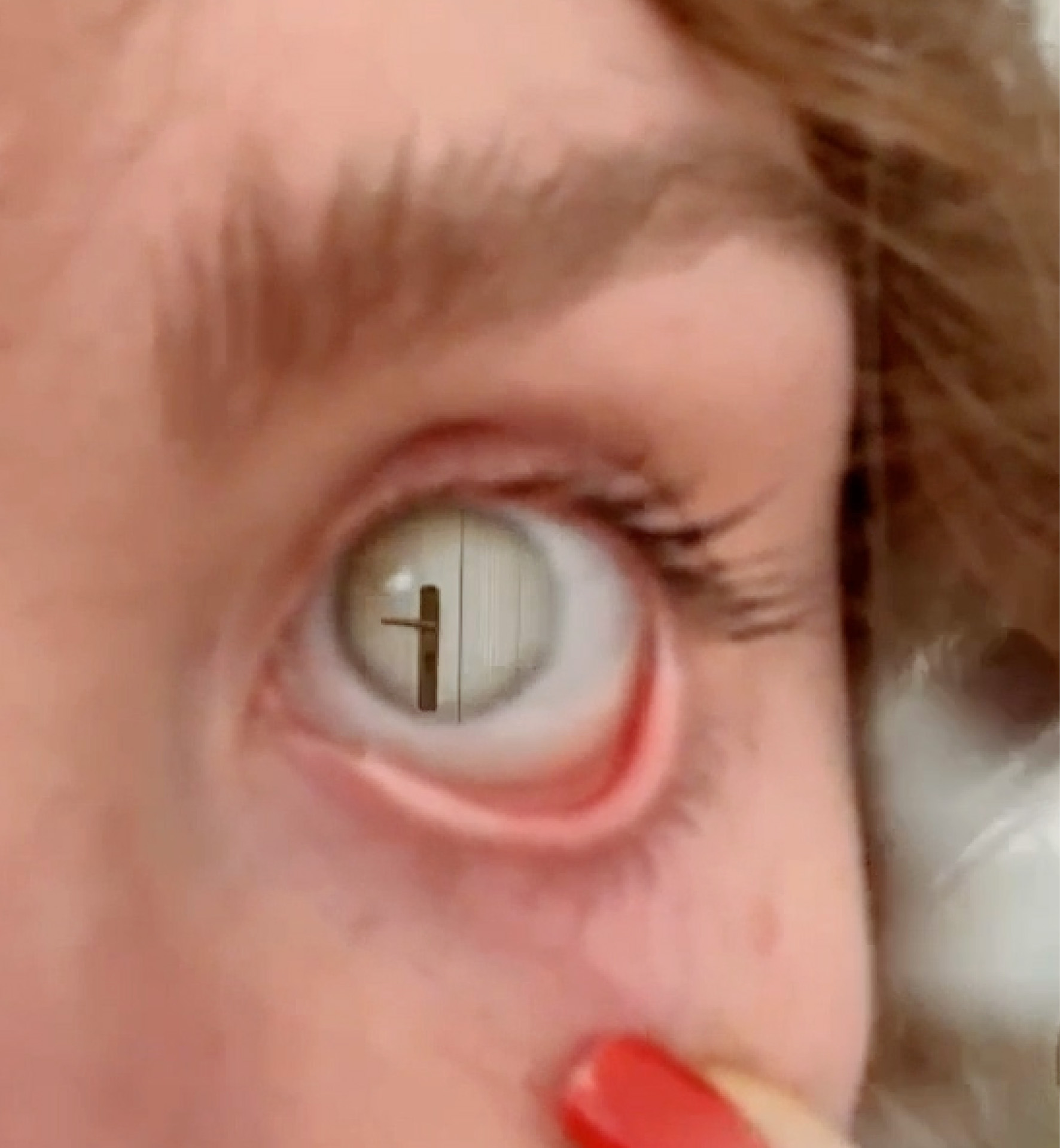
Screentesting: ( ghosts are made of bedsheets ), eine ebenfalls 2021 entstandene Videoinstallation, zeigt teils verzerrte und geisterhafte Bilder, die Lisa Hoffmann (geb. 1991 in Schlema) in einer Videoperformance in häuslicher Umgebung aufgenommen hat; sie werden auf Bioscreens projiziert. Diese Projektionsflächen bestehen aus von der Künstlerin hergestelltem kompostierbarem, gelatinebasiertem Bioplastik, ein Material, das sich im Laufe der Zeit nach und nach auflöst. In der Installation wird das Verhältnis zwischen dem technisch projizierten Bild und der organischen Projektionsfläche je nach Blickwinkel immer sonderbarer.
Screentesting: ( ghosts are made of bedsheets ), a video installation also produced in 2021, shows partially distorted and spectral images that Lisa Hoffmann (born in 1991 in Schlema) recorded in a video performance in a domestic environment; they are projected onto bioscreens. These projection surfaces consist of bioplastic manufactured by the artist that is compostable and gelatine-based; this is a material that gradually dissolves over time. In the installation the relationship between the technically projected image and the organic projection surface becomes, depending on the angle it is viewed from, ever stranger.
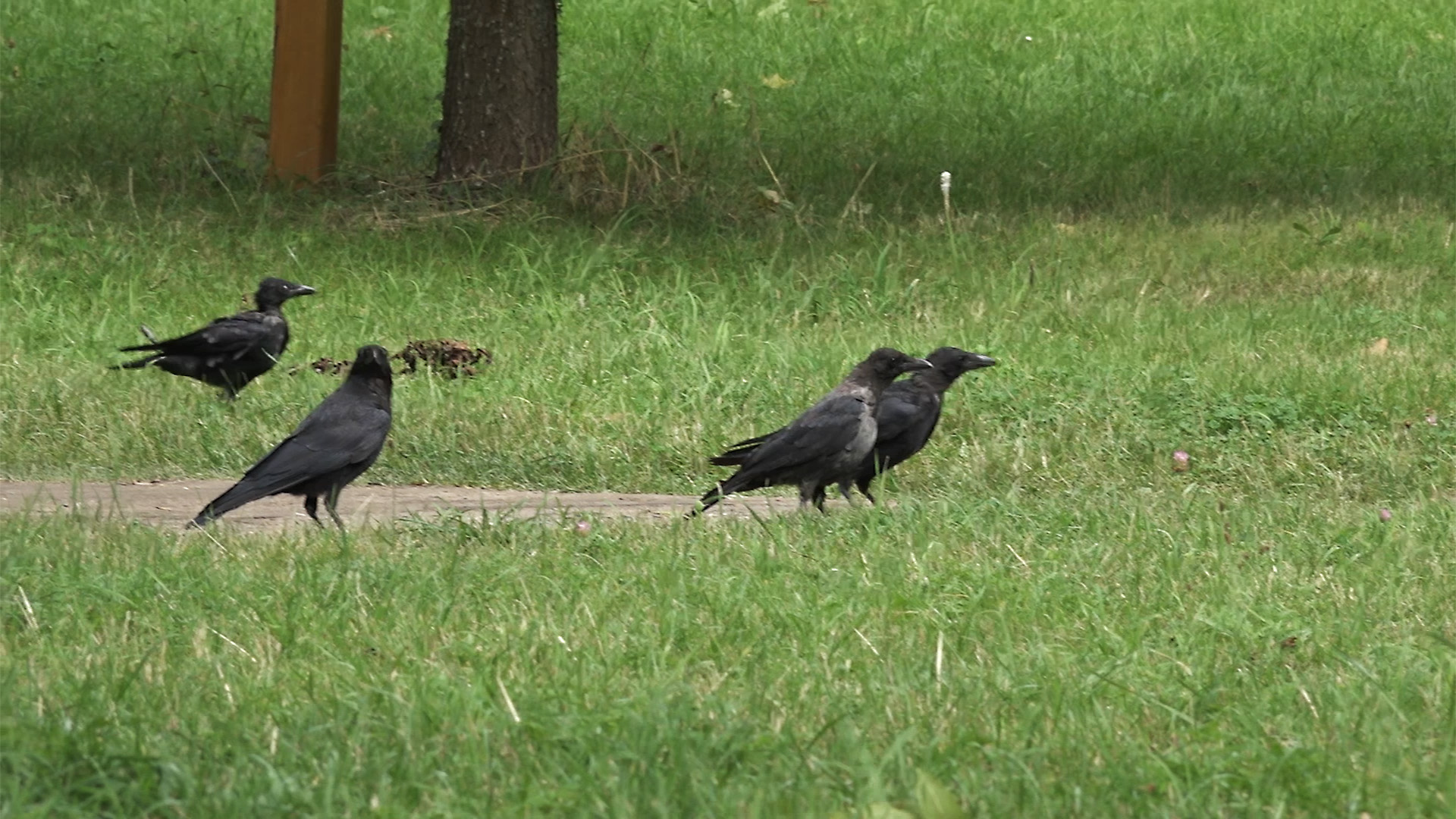
Die Videoinstallation Crow Calls Twice (2021) von Steph Joyce ist das Ergebnis einer monatelangen Erforschung der Beziehungen zwischen Menschen und Krähen aus verschiedenen Blickwinkeln. In ihrem filmischen Porträt würdigt Joyce die uns allgegenwärtigen Krähen, indem gezeigt wird, wie sich die Tiere in der von Menschen angelegten «Natur» adaptieren. Welche Formen der Begegnung sich ergeben und möglich sind, wird erst in der genauen Beobachtung offenbar. Seien es die Rufe der Krähen oder ihre Futtersuche im vom Menschen Verworfenen – überall gibt es Berührungspunkte, wenn man ihnen nur achtsam begegnet.
Steph Joyce’s video installation Crow Calls Twice (2021) is the result of months of researching the relationships between humans and crows from a range of perspectives. In her film portrait, Joyce appreciates crows, which are ubiquitous in our lives, by showing how the animals adapt in “nature” that has been shaped by people. The forms of encounter that result and are possible become apparent only upon careful observation. Whether it’s the crows’ cawing or their foraging for food in what humans have discarded—points of contact are everywhere if you just encounter them mindfully.
Preisträgerinnen des RUNDGANG 50HERTZ im Jahr 2021 sind:
Paula Ábalos, Elena Greta Falcini und Annabel Häfner – Sie wurden aus 300 Bewerbungen von einer Jury ausgewählt.
Das Thema des diesjährigen RUNDGANG 50HERTZ lautet: Kunst studieren im Lockdown. Was passiert, wenn sich eigentlich nichts mehr ereignet und sich das soziale Leben ausschließlich in den Bereich des Virtuellen verlagert? Wie können Künstler*innen dieses Vakuum kreativ nutzen und wie wirken sich die einschränkenden Maßnahmen konkret auf die künstlerische Arbeit aus? Diese Fragen, die in den vergangenen Monaten mit der Schließung von Ateliers, Werkstätten und Hochschulen das Leben von Kunststudierenden gravierend geprägt haben, sind Ausgangspunkt des Rundgang 50Hertz, für den die Jury Paula Ábalos, Elena Greta Falcini und Annabel Häfner auswählte.
The prizewinners of the RUNDGANG 50HERTZ in 2021 are:
Paula Ábalos, Elena Greta Falcini and Annabel Häfner – They were selected by a jury from 300 applications.
The theme of this year’s RUNDGANG 50HERTZ is: studying art during lockdown. What happens when nothing more is actually happening and social life shifts exclusively into the virtual realm? How can artists make creative use of this vacuum, and how do the restrictive measures concretely impact their artistic work? These questions, which, with the closing of studios, workshops, and art academies in the past months, have significantly marked the lives of art students, are the point of departure for Rundgang 50Hertz, for which the jury chose Paula Ábalos, Elena Greta Falcini and Annabel Häfner.

In der Filmarbeit von Paula Ábalos (* 1989 in Santiago de Chile) geht es um eine Arbeitskraft, die nachts einsam und allein ein Fitnessstudio reinigt. Grossformatige Fotografien an den Wänden zeigen die Ergebnisse der zur Optimierung des Körpers bereitgestellten Geräte. Allgewaltig kontrastieren Idealbilder trainierter Körper von totalitärem Ausmass die einzig real anwesende Person im Raum, deren Erschöpfung mit der Reinigung eines jeden Gerätes zunimmt. Das Verhältnis zwischen diesen beiden Ebenen – zwischen abwesendem Idealbild und anwesendem Realbild – wird im Verlaufe der Nacht immer sonderbarer.
Paula Ábalos’ (born in 1989 in Santiago de Chile) film project is about a worker cleaning a fitness studio at night, solitary and alone. Large-scale photographs on the walls show the results of the machinery provided for optimising the body. Omnipotently, ideal images of trained bodies of totalitarian proportions contrast with the sole person truly present in the room, whose exhaustion increases with the cleaning of each machine. The relationship between these two levels – between absent ideal image and present real image – becomes ever more peculiar in the course of the night.

Elena Greta Falcini (* 1986 in Eggenfelden) ist fasziniert von der Alchemie. Sie erforscht und erfindet unterschiedliche Materialien, die sie nachts aus geheimnisvollen Ingredienzien in ihrem Atelier zusammenbraut. Dieser Schaffensprozess wird begleitet von Fragen wie: Was ist Material? Wie zeigt es sich? Ist es autonom? Getrieben von einem Erkenntnisinteresse nach den Bedingungen der Entstehung und Beschaffenheit von Materialität an sich geht Falcini den Dingen auf den Grund. Sie beauftragt ein Forschungsinstitut, das von ihr erfundene Material zu entschlüsseln und in eine wissenschaftliche Formel zu übersetzen. Das laborähnliche Setting dieser Erkundung ist genauso Teil ihrer Installation, wie ihre von den Experimenten gezeichneten Arbeitsschuhe.
Elena Greta Falcini (born in 1986 in Eggenfelden) is fascinated by alchemy. She researches and invents various materials that she concocts at night in her studio out of mysterious ingredients. This creative process is accompanied by questions like: What is material? How does it arise? Is it autonomous? Driven by an epistemological interest in the conditions of the origin and properties of materiality per se, Falcini gets to the bottom of things. She engages a research institute to decipher the material she has invented and translate it into a scientific formula. The laboratory-like setting of this exploration is just as much part of her installation as her working shoes, which are marked by the experiments.
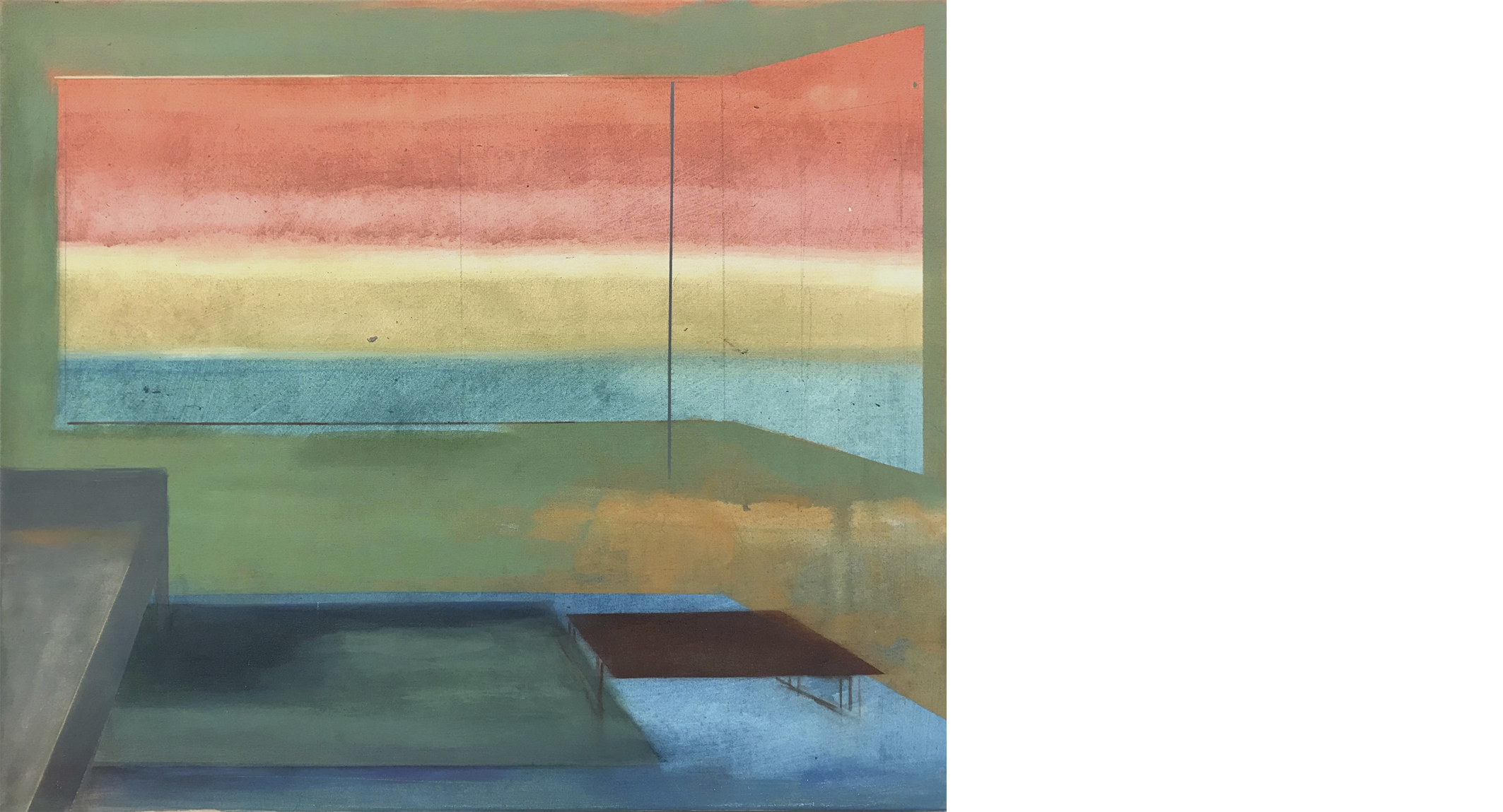
Annabell Häfner (* 1993 in Bonn) malt «Nicht-Orte». Der französische Ethnologe und Anthropologe Marc Augé hat 1992 ein Buch mit demselben Titel über dieses in einer globalisierten Welt aufscheinende Phänomen verfasst. «Nicht-Orte» sind anonyme Orte, ohne individuelle Identität, die Menschen nur kurz passieren. Hier entstehen keine sozialen Beziehungen, es sind gleichförmige Orte, an denen man nicht selten auf sich selbst zurückgeworfen wird. Von diesen sogenannten Transiträumen (dazu zählen Bahnhöfe, Flughäfen, Raststellen, Einkaufszentren etc.) wählt Annabell Häfner Hotelzimmer aus. Sie übersetzt den Charakter der sogenannten «Nicht-Orte» in ihre Malweise. Flüchtigkeit und Geschwindigkeit bestimmen den Duktus. Schicht für Schicht entfernt sie sich immer mehr vom Motiv des Hotelzimmers. Auf diese Weise entstehen atmosphärische Farb-Orte.
Annabell Häfner (born in 1993 in Bonn) paints “non-places”. The French ethnologist and anthropologist Marc Augé published a book of the same title in 1992 about this phenomenon that occurs in a globalised world. “Non-places” are anonymous places, places without individual identity that people pass through just briefly. No social relationships develop here; they are uniform places where one is thrown back on oneself. From among these so-called transit spaces (which include train stations, airports, rest stops, shopping centres, etc.) Annabell Häfner selects hotel rooms. She translates the character of the so-called “non-places” into her painting style. Ephemerality and speed define the characteristic style. Layer by layer, she distances herself ever more from the motif of the hotel room. In this way, atmospheric colour places emerge.
Adrian Altintas, Cora Czarnecki, Thomas Mader
Adrian Altintas, Cora Czarnecki, Thomas Mader
Ana Belén Cantoni, Judith Dorothea Gerke, Timo Hinze
Ana Belén Cantoni, Judith Dorothea Gerke, Timo Hinze
Emma Adler, Asana Fujikawa, Susanne Keichel, Cosima zu Knyphausen
Emma Adler, Asana Fujikawa, Susanne Keichel, Cosima zu Knyphausen

